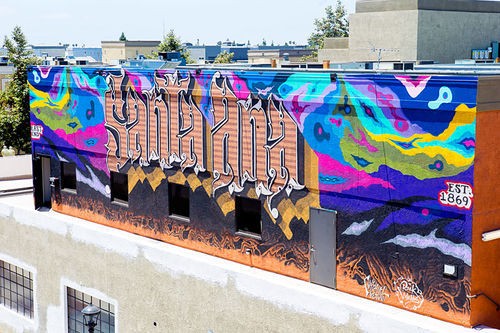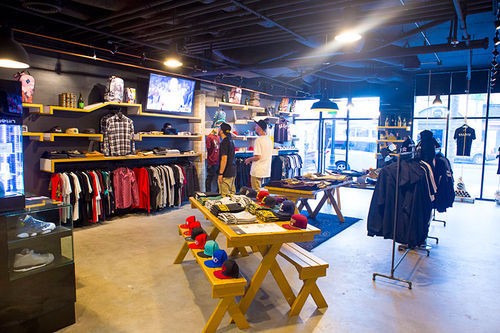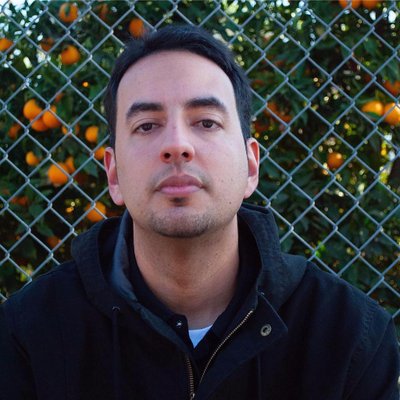
A graffiti mural splashed with color and the words Santa Ana looms from the rooftop over the courtyard between Fourth and French streets. In the left-hand corner of the piece, the artist tagged the phrase “East End”–the new name of the area known for decades as Fiesta Marketplace. The brick layered walkways of Plaza Santa Ana used to be home to El Faisan, a collection of kiosks offering Westernwear and Mexican imports before disappearing like many other immigrant businesses before it.
Nowadays, the sights and sounds of traditional Latino culture are surrounded by clubs and outdoor shows pumping heavy bass and boom-bap. Clothing shops sling expensive caps and designer sneakers, as shiny cowboy boots and tejanas fade into the background. As the market expands in the plaza, it's natural to believe hip-hop culture is becoming one of the strongest elements in the city's continuing gentrification.
]
Ironically, El Centro Cultural de Mexico volunteer and rapper IllNess Infection (born Nestor Medrano) voices his complaints about the cultural shift in a rap song called “Santa Ana Savage.” “East End?/¡No se lo que dicen!” Medrano raps, chiding the renaming of the area.
“To me, it's always going to be La Cuatro,” Medrano says. “In hip-hop–and this is one of the strongest rules–you can't grab the torch unless it's passed to you. [Downtown Inc.] should have waited for the blessing of the people who were here. But they didn't.”
Ryan Chase, president of Downtown Inc. and son of property owner Irv Chase, has long been sold on the idea of making Santa Ana a gentrified urban center, with entertainment and retail central to his vision. He spoke with the Fifth Element Magazine, a hip-hop-flavored website, in December about the changes: “I've noticed just growing up in Irvine, which is about as cookie-cutter as it gets, I always wanted something different. I was always into urban areas. Orange County doesn't have that.”
Near the Artists Village downtown sits the Santora Building, which houses GCS Clothing. It's one of a growing handful of stores catering to graffiti artists, skaters and hip-hop-heads. “Where some establishments try to push a certain style, we try to push a certain culture,” GCS owner Hector Ruiz says. “My goal with this business is to tie the culture together.”
In addition to apparel, the youth-centric store sells spray paint and markers and hangs pieces by local artists. But despite the apparent influx of hip-hop culture in Santa Ana, GCS recently announced it's closing that location. “The rent is way too expensive here in this building,” Ruiz says.
[

Young urban hipsters going to club nights and restaurants hasn't translated into a enough of an increase in revenue for the business.
Ruiz says the levies on downtown businesses also played a role in the shop's closing. “It's definitely gone up three or four times over. I definitely don't see three or four times over the amount of people here,” he says. “In fact, services have gone down.”

While the fate of GCS casts doubt on the purchasing power of the hip-hop community in downtown, Tyson Pruong, a Santa Ana native and event promoter, remains hopeful. He often helps to put together events with the Konsept art collective. At first, downtown Santa Ana didn't seem inviting to his vision. But for the past couple of years, Pruong has worked to change that, throwing more events that align with where he believes the market is heading.
For September, Konsept is planning a big music festival, with hip-hop and street artists among the focal points. Pruong says he envisions the event will take up an entire street. “We want to do it during the Art Walk [the first Saturday of the month], [when] we know there's going to be a good amount of foot traffic. That's a way of getting all the businesses wanting to do it as well,” says Pruong. “If anything would have a chance [to define this area], it probably would be hip-hop.”
Of course, whether it's called the East End or La Cuarto, locals and out-of-towners will play a pivotal role as to what changes to the neighborhood are really going to stick.
“One person's gentrification is another's improvement and evolution,” Ruiz says. “It depends on which side of the fence you're on.”
See also:
The Top 10 Rappers in OC
10 More of OC's Best Rappers
Top Five Female Emcees in OC
Follow us on Twitter at @OCWeeklyMusic and like us on Facebook at Heard Mentality.

Gabriel San Román is from Anacrime. He’s a journalist, subversive historian and the tallest Mexican in OC. He also once stood falsely accused of writing articles on Turkish politics in exchange for free food from DönerG’s!

